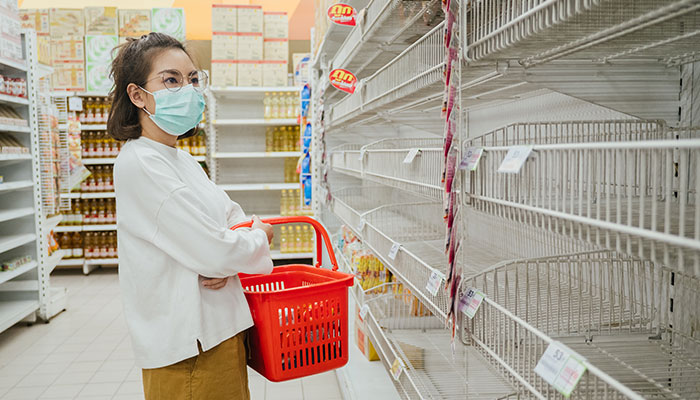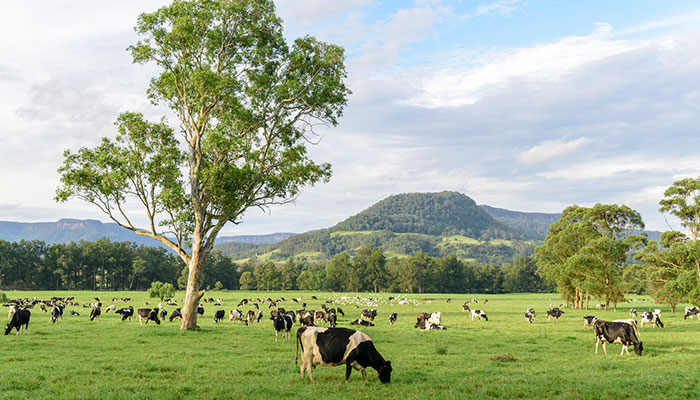The COVID-19 pandemic has once again highlighted the structural shortcomings in the grocery supply chain, from the farmgate to the supermarket checkout, as well as the unique challenges Australia faces.

The rapid spread of the Omicron variant affected not only production, with dairy and abattoir workers for example testing positive, but at the same time hit downstream workers in processing and packaging, transport and distribution, as well as the supermarket staff who replenish the shelves.
The result has been scarce milk, meat, fruit and vegetables, and many consumers either panic-buying, going without or looking for alternative sources of supply.
Over specialisation
The pandemic aside, the root cause of this disruption is structural and systemic, and stems from the over-specialisation of our whole economic system involving farming, manufacturing, packaging, transport and distribution. The pandemic is the last card that’s brought the house down — at least for a few weeks, according to supermarket executives.
Specialisation is the entire basis of modern economies and trade — an idea that goes back to the Scottish economist Adam Smith. In the economically developed world, such as Australia, we’ve got Adam Smith’s idea on steroids. Every stage of the food supply chain is extremely specialised and there are multiple stages and parties between the producer and the consumer.

Chain gang: a series of operations involving pickers, warehouse workers, packaging staff, drivers and supermarket staff get cherries and most other fresh food from farm to check out.
Let’s take cherries, for example: someone picks them, then they’re taken to a warehouse where they’re packaged (with packaging produced elsewhere and sometimes imported from overseas). Then they’re loaded onto trucks, transported to a distribution warehouse most often for Coles or Woolworths, and finally delivered to supermarkets around Australia.
It means that if any one of these separate operations are impacted, the whole chain is disrupted.
Distance + duopoly = unique market conditions
The duopoly of Coles and Woolworths is also a significant problem. Their operations underpin a staggering 66 per cent of the grocery supply chain. That’s very different from most other Western countries, such as the US, UK, Canada or Germany where there are more players in the sector and therefore more diversity – particularly of supply chains.
Australia also has unique issues on its farms. For example, in the case of cattle production, our farmers earn an average 33 per cent farm share— compared to the average American farmer who gets almost 50 per cent. Farm share is the proportion of farm value in the retail price of a food item purchased at a retail store.
This is in part because Australia’s labour costs are higher and there are also economies of scale that work against Australian farmers since the US population is 13 times bigger than Australia’s.
Most Australian cattle are also pasture-fed rather than grain-fed like the US and coupled with floods and droughts this means an Australian farmer runs a more risky business compared to their global counterparts.
Then there’s packaging. A large proportion comes from overseas, because we have a small manufacturing sector and much of the packaging production is controlled by a few companies, some of which have faced legal action for running cartels. This oligopoly also makes us vulnerable to disruptions.

Milky ways: In Australia, Dr Karunaratne says milk travels twice as far from dairy farms to producer to manufacturers than it does in NZ for example, making the industry haveily reliant on efficient transportation and distribution.
Transportation and distribution is another issue. Australia’s fresh produce travels considerable distances around the country. For example, raw unpasteurised milk in Australia travels almost twice as far from the farm to the plant producer to the manufacturer than it does in New Zealand.
What you can do to get around shortages
There’s no quick fix to these structural issues. Government policy won’t change them overnight. But as an individual, you can take some actions to pre-empt or cope with the current or future disruptions.
Although stockpiling may be tempting, a better strategy for you and the wider community is to diversify your food suppliers, including buying from independent grocers or farmers’ markets with more direct access to growers.
Other community-supported agricultural procurement models include a subscription to purchase a weekly box of vegetables, fruit or meat directly from the farmer. You could also go to a farm that allows pick-your-own fruit or buy from the farmgate.
Growing your own vegetables and keeping chickens at home or in community gardens is a possible solution – but isn’t for everyone.
Most importantly, we need to foster a more diverse supermarket industry, as well as ensure major players have adequate risk management processes in place which governments could monitor and regulate, just as they do for the financial sector.

Dr Prashan Karunaratne (pictured) is Course Director for the Bachelor of Commerce and senior lecturer in the Department of Actuarial Studies and Business Analytics in the Macquarie Business School.







